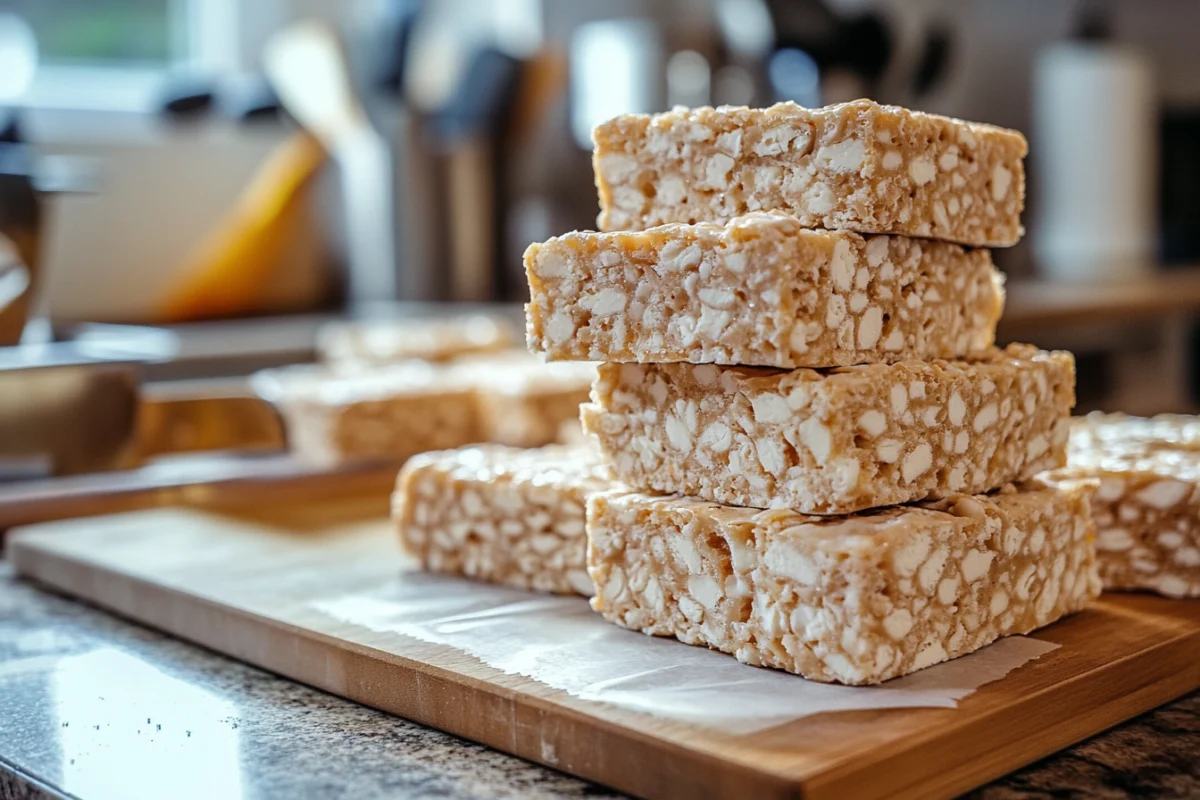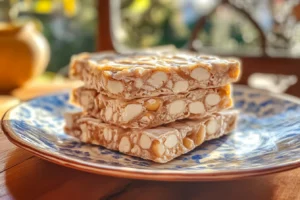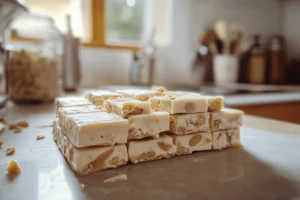Turron is a traditional Mediterranean nougat confection that has become synonymous with Spanish culture, particularly during the holiday season. The treat is typically made from a blend of three simple ingredients: honey, sugar, and egg whites, combined with toasted almonds or other types of nuts. While it may appear similar to nougat in other regions, it holds a unique identity in Spain, where it is closely linked to Christmas traditions.
The Origins and History
The story of turron is deeply embedded in Spanish culture. It is believed that the Moors introduced the concept of nougat during their reign in Spain, which eventually evolved into the nougat we know today.
- Moorish Influence
- The Moors brought almonds and sugar into the region, forming the foundation of it. The recipe became an essential part of Mediterranean cuisine, particularly in Valencia and Alicante.
- Evolution Over Time
- The spread of this nougat throughout Spain during the Middle Ages played a significant role in shaping regional varieties. In Alicante, the hard Turron de Alicante was developed, while in Jijona, the softer Turron de Jijona became popular.
- Modern Production
- Although traditional methods are still widely used, it has evolved with modern technology, making it more accessible worldwide. The use of Marcona almonds and orange blossom honey has solidified its place in Spanish holiday traditions.
Different Types
There are two primary types of: the hard variety (Turron de Alicante) and the soft variety (Turron de Jijona). Each has unique characteristics based on its ingredients and preparation.
- Turron de Alicante (Hard)
- This variety is characterized by its crunchy texture, which comes from the large, whole almonds embedded in a firm sugar and honey base.
- The Turron de Alicante is perfect for those who prefer a chewy yet crisp nougat experience.
- Turron de Jijona (Soft)
- In contrast, Turron de Jijona is softer and smoother. It is made with finely ground almonds, resulting in a creamy texture that is less crunchy than the Alicante variety.
- The smoothness of Turron de Jijona makes it particularly popular with those who enjoy a milder, melt-in-your-mouth confection.
- Other Regional Variants
- While Turron de Alicante and Turron de Jijona are the most well-known, there are other regional varieties of this nougat. These may include Turron de Yema Tostada (a variety with a toasted egg yolk center) or even chocolate-covered turron that includes various fillings such as fruit, cream, or other nuts.
For those interested in trying new recipes, check out our corn nuggets recipe, which offers a different, but similarly sweet and crispy experience.
Ingredients and Preparation
Key Ingredients
Made from a small, select group of ingredients that contribute to its rich, sweet flavor and smooth texture. The three most important ingredients in turron are almonds, honey, and egg whites. Each ingredient plays a vital role in crafting this traditional Spanish treat.
- Almonds
- The star ingredient in turron is undoubtedly the almond. The finest variety used is the Marcona almond, grown predominantly in Spain.
- Marcona almonds are prized for their rich, buttery flavor and slightly sweet taste. They contribute to the smooth texture and the distinct taste of turron.
- Honey
- Honey, often from orange blossoms, is a critical component. The flavor of the honey can influence the final taste of the turron, adding subtle floral notes to the otherwise nutty profile.
- The use of honey instead of sugar alone gives turron a smoother, more complex sweetness that balances the almonds.
- Egg Whites and Sugar
- Egg whites are used to bind the ingredients together. When whipped, they provide the texture necessary to give turron its characteristic softness.
- Sugar is also essential, contributing both sweetness and structure, as it helps the turron set once it’s cooled.
5. How Turron is Made
The process of making turron has remained largely unchanged for centuries, although modern methods have made it more accessible.
- Traditional Preparation Methods
- The basic process begins by heating honey and sugar in a large pot until it reaches the right consistency. This is done slowly and carefully to avoid burning the honey.
- Next, egg whites are whipped into a soft meringue and mixed with the honey-sugar mixture.
- The almonds are then roasted and added to the mixture, giving the turron its distinctive crunch.
- The final step involves spreading the mixture into molds and allowing it to cool and set.
- Modern Production Methods
- In contemporary times, large-scale production uses machinery to mix ingredients and form the nougat. While the turron is still made with the same fundamental ingredients, automated processes help produce it faster and more consistently.
- However, many artisanal producers still use the traditional hand-crafted method, which is considered by many to produce the highest quality turron.
The Cultural Significance
Turron in Spanish Culture
It is much more than a simple dessert; it is an essential part of Spanish culture, particularly during the Christmas season.
- as a Christmas Tradition
- In Spain, turron is a beloved holiday treat. It’s often served during Nochebuena (Christmas Eve) dinners and is a symbol of togetherness and festive cheer.
- The popularity of turron during Christmas is so great that many families will exchange boxes of it as gifts, ensuring that no home is without this sweet treat.
- Regional Significance and Variations
- Each region of Spain has its own variation of this nougat. For example, Turron de Alicante is favored in the Valencia region, while Turron de Jijona is popular in Alicante.
- These regional differences not only reflect local tastes but also the specific types of almonds and honey available in each area, highlighting the deep-rooted connection between turron and the Spanish landscape.
- in Family Gatherings and Celebrations
- It is often associated with family traditions. Many families gather around the Christmas table to share stories and enjoy turron as a central part of their celebration.
- The turron serves as a reminder of the season’s joy and the importance of family, making it a truly sentimental treat.
Outside of Spain
As it has grown in popularity, it has made its way beyond Spain and is now enjoyed by people all around the world.
- Global Popularity
- It has become a well-known holiday treat in many countries, particularly in Latin America. In countries like Mexico and Argentina, turron is enjoyed during the Christmas season, and variations such as turron de dulce de leche have emerged.
- Variants and Adaptations in Other Countries
- Other countries have adapted turron to fit local tastes, incorporating indigenous ingredients like coconut, chocolate, and even fruit into the nougat.
- Export and Commercialization
- Spain is the leading exporter of turron, and it is available in many international supermarkets during the holiday season. The commercialization of turron has allowed people around the globe to experience this traditional Spanish sweet.
How to Enjoy
Best Ways to Serve and Enjoy
It is a versatile treat that can be enjoyed in many different ways. Whether you’re celebrating a holiday or simply indulging in a sweet snack, there are several ways to serve and pair turron for an enhanced experience.
- Serving During the Holidays
- During the Christmas season, it’s often served as a standalone treat or paired with a glass of sherry or Cava, two beverages that complement its sweetness.
- Traditionally, turron is sliced into small pieces, allowing guests to sample the different varieties available, such as Turron de Alicante and Turron de Jijona.
- Pairing with Other Sweets
- Turron pairs wonderfully with other Mediterranean desserts, such as polvorones (Spanish shortbread cookies) and mazapan (marzipan). The combination of different textures and flavors creates a delightful array of tastes.
- You can also serve turron alongside fresh fruits like figs, grapes, and apples to add a refreshing balance to the sweetness of the nougat.
- Incorporating into Recipes
- It can also be used as an ingredient in other recipes. For example, you can crumble pieces of Turron de Alicante into ice cream or use Turron de Jijona to make a rich, almond-flavored cake.
- Some chefs even incorporate turron into savory dishes, such as roasted meats or salads, to add a touch of sweetness and crunch.
- in Modern Desserts
- In recent years, turron has been incorporated into modern dessert creations. Some popular recipes include turron ice cream, turron mousse, or even turron-flavored chocolate bars. These modern takes allow people to enjoy turron in new and innovative ways.
Turron as a Gift
It is often exchanged as a gift during Christmas and other holidays. Its rich cultural significance makes it a thoughtful and meaningful gift, especially for those who enjoy traditional sweets.
- Packaging for Gifting
- It is usually packaged in elegant boxes or tins, making it a perfect gift for family and friends. The packaging is often decorated with festive designs, adding to the celebratory feel of the gift.
- Personalized Gifts
- Many artisanal turron makers offer custom packaging or even personalized flavors. For example, you can find turron made with specific nuts or chocolate for someone with particular tastes.
- as Corporate Gifts
- Turron is also a popular corporate gift during the holiday season. Companies often give branded turron boxes to clients or employees, sharing a piece of Spanish tradition while showing appreciation.
Health Benefits and Nutritional Information
Nutritional Value
Whileit is undoubtedly a sweet treat, it can also offer some nutritional benefits, thanks to its high-quality ingredients like almonds, honey, and egg whites.
- Almonds in Turron
- Almonds are a rich source of healthy fats, including monounsaturated fats, which are beneficial for heart health. They also provide protein, fiber, and essential vitamins like Vitamin E and B2.
- Honey as a Natural Sweetener
- Honey is not only a sweetener but also contains antioxidants and antimicrobial properties. It has a lower glycemic index compared to sugar, making it a more natural choice for those who want a more balanced sweet treat.
- Egg Whites in Turron
- Egg whites are low in calories and high in protein, contributing to muscle repair and growth. They also provide a light and airy texture to the turron, making it a treat that feels indulgent without being overly heavy.
- Potential Health Benefits
- Due to its almond content, turron is rich in fiber and healthy fats, which can help improve digestion and regulate blood sugar levels.
- The antioxidants in honey can also help combat oxidative stress and promote overall wellness.
Is It Healthy?
While turron can offer some health benefits, it’s still a sugary treat and should be enjoyed in moderation.
- Calories and Sugar Content
- Turron is calorie-dense, as it contains a fair amount of sugar, honey, and almonds. A small piece of turron can have around 150–200 calories, depending on the variety.
- Moderation is Key
- Due to the calorie content, it’s important to enjoy turron as an occasional indulgence rather than a daily snack. However, when consumed in moderation, it can be a satisfying and relatively nutritious treat.
- Healthier Alternatives
- If you’re looking for a healthier alternative, you might opt for turron made with less sugar or a sugar-free version that uses stevia or erythritol as a sweetener.
Frequently Asked Questions (FAQs)
What is the difference between Turron de Alicante and Turron de Jijona?
The primary difference lies in their texture and consistency:
- Turron de Alicante is crunchy and firm, made with whole almonds and a hard sugar base.
- Turron de Jijona is smooth and soft, with finely ground almonds that create a creamy, almost paste-like texture.
Where can I buy authentic Turron?
You can find authentic turron in specialty food stores, particularly those that carry Mediterranean or Spanish products. Many artisanal producers offer high-quality turron online, making it accessible year-round. Major supermarkets in Spain also stock turron during the Christmas season.
How long does It last?
Turron has a long shelf life when stored properly. It can last for several months if kept in a cool, dry place, away from direct sunlight. It is recommended to consume it within 6–12 months for the best flavor and texture.
Can Turron be made without eggs?
Yes, turron can be made without eggs, although the texture will differ. Some modern recipes use agar-agar or other binding agents as a substitute for egg whites, making it suitable for those with egg allergies or those following a vegan diet.
What are some variations of Turron?
While Turron de Alicante and Turron de Jijona are the most popular, other variations include:
- Turron de chocolate (chocolate-covered nougat).
- Turron de yema tostada (made with toasted egg yolk).
- Turron de frutas (turron with dried fruits).
you can explore more recipes on eira recipes.
Conclusion:
It is more than just a sweet treat, it is a symbol of tradition, craftsmanship, and the rich culinary heritage of Spain. Originating from the Mediterranean, it has evolved over centuries, becoming an integral part of Spanish culture, particularly during the Christmas season. Whether enjoyed at family gatherings, holiday feasts, or shared as a thoughtful gift, turron represents the warmth and generosity that are central to Spanish celebrations.
Explore more about different holiday treats in our guide to corn nuggets and their variations.



